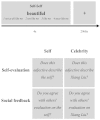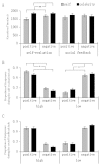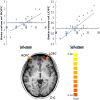Trait self-esteem and neural activities related to self-evaluation and social feedback
- PMID: 26842975
- PMCID: PMC4740758
- DOI: 10.1038/srep20274
Trait self-esteem and neural activities related to self-evaluation and social feedback
Abstract
Self-esteem has been associated with neural responses to self-reflection and attitude toward social feedback but in different brain regions. The distinct associations might arise from different tasks or task-related attitudes in the previous studies. The current study aimed to clarify these by investigating the association between self-esteem and neural responses to evaluation of one's own personality traits and of others' opinion about one's own personality traits. We scanned 25 college students using functional MRI during evaluation of oneself or evaluation of social feedback. Trait self-esteem was measured using the Rosenberg self-esteem scale after scanning. Whole-brain regression analyses revealed that trait self-esteem was associated with the bilateral orbitofrontal activity during evaluation of one's own positive traits but with activities in the medial prefrontal cortex, posterior cingulate, and occipital cortices during evaluation of positive social feedback. Our findings suggest that trait self-esteem modulates the degree of both affective processes in the orbitofrontal cortex during self-reflection and cognitive processes in the medial prefrontal cortex during evaluation of social feedback.
Figures




Similar articles
-
Activations of the dorsolateral prefrontal cortex and thalamus during agentic self-evaluation are negatively associated with trait self-esteem.Brain Res. 2018 Aug 1;1692:134-141. doi: 10.1016/j.brainres.2018.05.017. Epub 2018 May 16. Brain Res. 2018. PMID: 29777673 Free PMC article.
-
The neural basis of trait self-esteem revealed by the amplitude of low-frequency fluctuations and resting state functional connectivity.Soc Cogn Affect Neurosci. 2016 Mar;11(3):367-76. doi: 10.1093/scan/nsv119. Epub 2015 Sep 23. Soc Cogn Affect Neurosci. 2016. PMID: 26400859 Free PMC article.
-
Brain regions in response to character feedback associated with the state self-esteem.Biol Psychol. 2019 Nov;148:107734. doi: 10.1016/j.biopsycho.2019.107734. Epub 2019 Jul 25. Biol Psychol. 2019. PMID: 31352028
-
Inferences about mental states.Philos Trans R Soc Lond B Biol Sci. 2009 May 12;364(1521):1309-16. doi: 10.1098/rstb.2008.0318. Philos Trans R Soc Lond B Biol Sci. 2009. PMID: 19528012 Free PMC article. Review.
-
Cortical midline structures and autobiographical-self processes: an activation-likelihood estimation meta-analysis.Front Hum Neurosci. 2013 Sep 4;7:548. doi: 10.3389/fnhum.2013.00548. Front Hum Neurosci. 2013. PMID: 24027520 Free PMC article. Review.
Cited by
-
A Fluid Self-Concept: How the Brain Maintains Coherence and Positivity across an Interconnected Self-Concept While Incorporating Social Feedback.J Neurosci. 2023 May 31;43(22):4110-4128. doi: 10.1523/JNEUROSCI.1951-22.2023. Epub 2023 May 8. J Neurosci. 2023. PMID: 37156606 Free PMC article.
-
Analyzing brain structural differences among undergraduates with different grades of self-esteem using multiple anatomical brain network.Biomed Eng Online. 2021 Feb 12;20(1):20. doi: 10.1186/s12938-021-00853-z. Biomed Eng Online. 2021. PMID: 33579302 Free PMC article.
-
Brain fingerprint and subjective mood state across the menstrual cycle.Front Neurosci. 2024 Dec 6;18:1432218. doi: 10.3389/fnins.2024.1432218. eCollection 2024. Front Neurosci. 2024. PMID: 39712222 Free PMC article.
-
Dissociation and other trauma symptomatology are linked to imbalance in the competing neurobehavioral decision systems.Front Psychol. 2024 Jan 31;14:1317088. doi: 10.3389/fpsyg.2023.1317088. eCollection 2023. Front Psychol. 2024. PMID: 38356995 Free PMC article.
-
The relationship between self-esteem and self-concept clarity is modulated by spontaneous activities of the dACC.Front Psychol. 2022 Oct 5;13:926181. doi: 10.3389/fpsyg.2022.926181. eCollection 2022. Front Psychol. 2022. PMID: 36275295 Free PMC article.
References
-
- James W. The principle of psychology. Vol. 1 (Henry Holt, 1890).
-
- Leary M. R. Making sense of self-Esteem. Current Directions in Psychological Science 8, 32–35 (1999).
-
- MacDonald G., Saltzman J. L. & Leary M. R. Social approval and trait self-esteem. Journal of Research in Personality 37, 23–40 (2003).
-
- Leary M. R., Tambor E. S., Terdal S. K. & Downs D. L. Self-Esteem as an Interpersonal Monitor: The Sociometer Hypothesis. Journal of personality and social psychology 68, 518–530 (1995).
-
- Leary M. R. & Baumeister R. F. The nature and function of self-esteem: Sociometer theory. Advances in Experimental Social Psychology 32, 1–62 (2000).
Publication types
MeSH terms
LinkOut - more resources
Full Text Sources
Other Literature Sources
Medical

